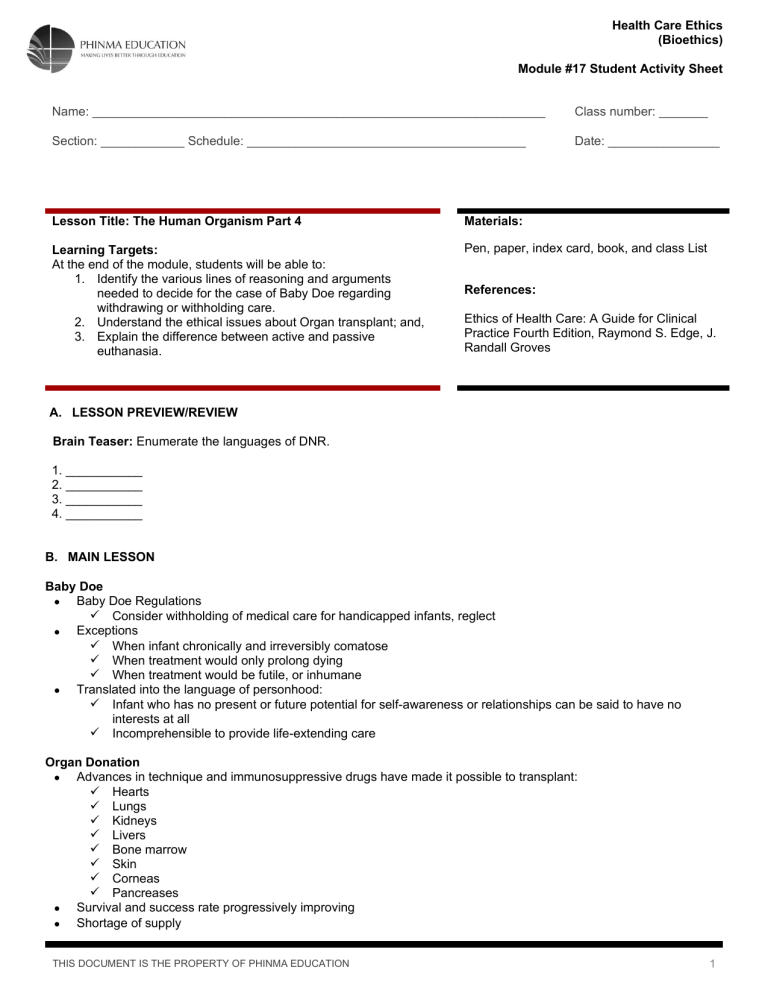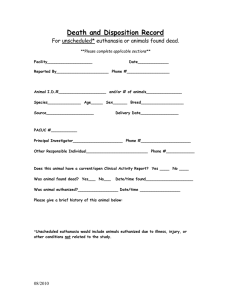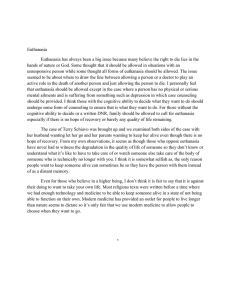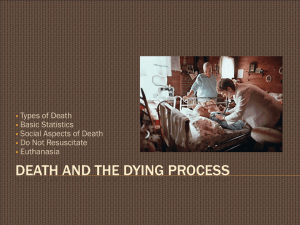
Health Care Ethics (Bioethics) Module #17 Student Activity Sheet Name: _________________________________________________________________ Class number: _______ Section: ____________ Schedule: ________________________________________ Date: ________________ Lesson Title: The Human Organism Part 4 Materials: Learning Targets: At the end of the module, students will be able to: 1. Identify the various lines of reasoning and arguments needed to decide for the case of Baby Doe regarding withdrawing or withholding care. 2. Understand the ethical issues about Organ transplant; and, 3. Explain the difference between active and passive euthanasia. Pen, paper, index card, book, and class List References: Ethics of Health Care: A Guide for Clinical Practice Fourth Edition, Raymond S. Edge, J. Randall Groves A. LESSON PREVIEW/REVIEW Brain Teaser: Enumerate the languages of DNR. 1. ___________ 2. ___________ 3. ___________ 4. ___________ B. MAIN LESSON Baby Doe Baby Doe Regulations Consider withholding of medical care for handicapped infants, reglect Exceptions When infant chronically and irreversibly comatose When treatment would only prolong dying When treatment would be futile, or inhumane Translated into the language of personhood: Infant who has no present or future potential for self-awareness or relationships can be said to have no interests at all Incomprehensible to provide life-extending care Organ Donation Advances in technique and immunosuppressive drugs have made it possible to transplant: Hearts Lungs Kidneys Livers Bone marrow Skin Corneas Pancreases Survival and success rate progressively improving Shortage of supply THIS DOCUMENT IS THE PROPERTY OF PHINMA EDUCATION 1 Health Care Ethics (Bioethics) Module #17 Student Activity Sheet Name: _________________________________________________________________ Class number: _______ Section: ____________ Schedule: ________________________________________ Date: ________________ Uniform Anatomical Gift Act Purely voluntary decision Organs may be donated by those close to individual Need to obtain family consent in time of grief and stress major barrier to organ procurement Volunteerism and public education have not provided adequate supplies of donated organs Euthanasia Euthanasia refers to deliberately ending someone’s life, usually to relieve suffering. Doctors sometimes perform euthanasia when it’s requested by people who have a terminal illness and are in a lot of pain. It’s a complex process and involves weighing many factors. Local laws, someone’s physical and mental health, and their personal beliefs and wishes all play a role. Are there different types? There are several types of euthanasia. What’s chosen depends on a variety of factors, including someone’s outlook and level of consciousness. Assisted suicide vs. euthanasia Assisted suicide is sometimes called physician-assisted suicide (PAS). PAS means a doctor knowingly helps someone end their life. This person is likely experiencing persistent and unending suffering. They may have also received a terminally ill diagnosis. Their doctor will determine the most effective, painless method. In many Trusted Source cases, doctors will provide people with a drug they can take to end their life. A lethal dose of opioids, for example, may be prescribed for this. In the end, it’s up to the person to decide whether they take the drug. With euthanasia, a doctor is allowed to end the person’s life by painless means. For example, an injection of a lethal drug may be used. Active vs. passive When most people think of euthanasia, they think of a doctor directly ending someone’s life. This is known as active euthanasia. Purposely giving someone a lethal dose of a sedative is considered active euthanasia. Passive euthanasia is sometimes described as withholding or limiting life-sustaining treatments so that a person passes more quickly. A doctor may also prescribe increasingly high doses of pain-killing medication. Overtime, the doses may become toxic. This makes the distinction between passive euthanasia and palliative care blurry. Palliative care focuses on keeping people as comfortable as possible at the end of their life. For example, a palliative care doctor might allow someone approaching death to stop taking a medication that causes unpleasant side effects. In other cases, they might allow someone to take a much higher dose of a pain medication to treat severe pain. This is often a standard part of good palliative care. Many don’t consider it euthanasia. Voluntary vs. nonvoluntary If someone makes a conscious decision to seek help with ending their life, it’s considered voluntary euthanasia. The person must give their full consent and demonstrate that they fully understand what will happen. Nonvoluntary euthanasia involves someone else making the decision to end someone’s life. A close family member usually makes the decision. This is generally done when someone is completely unconscious or permanently incapacitated. It usually involves passive euthanasia, such as withdrawing life support from someone who’s showing no signs of brain activity. https://www.healthline.com/health/what-is-euthanasia#types (visit this page to understand facts about euthanasia) Legal and Social Standing of Euthanasia THIS DOCUMENT IS THE PROPERTY OF PHINMA EDUCATION 2 Health Care Ethics (Bioethics) Module #17 Student Activity Sheet Name: _________________________________________________________________ Class number: _______ Section: ____________ Schedule: ________________________________________ Date: ________________ 2016: Oregon and four other states allow physician-aid-in dying (PAD) No clear consensus for legalizing euthanasia Key points Passive Euthanasia Doing nothing to preserve life Active Euthanasia Requires actions that speed process of dying Involuntary Euthanasia Ignores individual’s autonomous rights Could bring about death of unwilling victim A person has committed suicide when: That person brings about his or her own death Others do not coerce him or her to do the action Death caused by conditions arranged by person for purpose of bringing about his or her death World Status of Euthanasia Netherlands: first modern industrialized nation to fully sanction physician assisted suicide German-speaking nations: law allows assisted suicide as long as drug is taken without any help Switzerland: allows physician assisted suicide as long as there are no “self-seeking motives” Belgium: second Western nation to legalize physician-assisted suicide; policies less stringent Netherlands United States: doctors allowed to prescribe lethal doses of drugs to terminally ill patients to “aid in dying” in five states; active euthanasia is illegal CHECK FOR UNDERSTANDING You will answer and rationalize this by yourself. This will be recorded as your quiz. One (1) point will be given to correct answer and another one (1) point for the correct ratio. Superimpositions or erasures in you answer/ratio is not allowed. 1. The Baby doe regulations consider the withholding of medical care for these handicapped infants to be neglect. The regulations provided three exceptions which are? A. When the infant is chronically and irreversibly comatose B. When the treatment would futile; or inhumane. C. When treatment would only prolong dying. D. All of the above Answer: ________ Rationale:________________________________________________________________________________________ _________________________________________________________________________________________________ _________________________________________________________________________________________________ 2. This Act was passed in the US in 1968 and has since revise in 1987 and in 2006. The act sets a regulatory framework for the donation of organs, tissues, and other human body parts in the US? A. Uniform Anatomical Gift Act of 2006 B. Patient Self-determination Act C. Consumers Act D. None of the above Answer: ________ Rationale:________________________________________________________________________________________ _________________________________________________________________________________________________ _________________________________________________________________________________________________ THIS DOCUMENT IS THE PROPERTY OF PHINMA EDUCATION 3 Health Care Ethics (Bioethics) Module #17 Student Activity Sheet Name: _________________________________________________________________ Class number: _______ Section: ____________ Schedule: ________________________________________ Date: ________________ 3. With regards to Options for Increasing the Supply of Salvageable Organ, this option would require all competent adults to decide and record whether they wish to become organ donors at their death. A. Presumed consent B. Mandated choice C. Xenografting D. All of the above Answer: ________ Rationale:________________________________________________________________________________________ _________________________________________________________________________________________________ _________________________________________________________________________________________________ 4. Failing to revive a patient who has signed a DNR order is an example of what type of euthanasia? A. Active euthanasia B. Involuntary euthanasia C. Passive euthanasia D. All of the above Answer: ________ Rationale:________________________________________________________________________________________ _________________________________________________________________________________________________ _________________________________________________________________________________________________ 5. It is the first modern industrialized nation to fully sanction physician-assisted suicide. A. Belgium B. Germany C. Netherlands D. United States Answer: ________ Rationale:________________________________________________________________________________________ _________________________________________________________________________________________________ _________________________________________________________________________________________________ C. LESSON WRAP-UP AL Activity: CAT: 3-2-1 Instructions: 1. As an exit ticket at the end of the class period 2. Record three things you learned from the lesson. 3. Next, two things that you found interesting and that you’d like to learn more about. 4. Then, record one question you still have about the lesson. Three things you learned: 1. __________________________________________________________________________________ 2. __________________________________________________________________________________ 3. __________________________________________________________________________________ Two things that you’d like to learn more about: THIS DOCUMENT IS THE PROPERTY OF PHINMA EDUCATION 4 Health Care Ethics (Bioethics) Module #17 Student Activity Sheet Name: _________________________________________________________________ Class number: _______ Section: ____________ Schedule: ________________________________________ Date: ________________ 1. __________________________________________________________________________________ 2. __________________________________________________________________________________ One question you still have: 1.___________________________________________________________________________________ THIS DOCUMENT IS THE PROPERTY OF PHINMA EDUCATION 5



